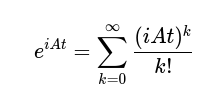The Representation of Unitary
An unitary matrix U is represented as (1), but why is it possible?
\begin{align}
U=e^{iH}
\end{align}The Hermite and its characteristic
The characteristic of Hermite is (2), means that a Hermite matrix H equals to its conjugate(adjoint) matrix.
So as we can see in (3), an adjoint of Hermite which is multiplied by an Imaginary number equals to the Hermite which is multiplied by minus imaginary value.
\begin{align}
H=H^{\dagger}\\
(iH)^{\dagger}=-iH
\end{align}The Characteristic of Unitary and its Representation
if you multiply an unitary matrix with adjoint of the unitary, you get unit matrix (4).
\begin{align}
UU^{\dagger}=I
\end{align}Let assume that Unitary can be described in terms of Hermie. And substitute equation (1) into equation (4).
\begin{align}
UU^{\dagger}=\\
e^{iH}(e^{iH})^{\dagger}=e^{iH}{e^{(iH)^{\dagger}}}
\end{align}by using the relation (3),
\begin{align}
e^{iH}{e^{(iH)^{\dagger}}}
=e^{iH}{e^{-iH}}=e^0=I \\
\end{align}So, this U (1) is obviously Unitary matrix.
The Representation of Hermite
As we can see below article, Hermite is represented as linear combination of Pauli and Unit matrices which is Hermite as well. What’s important here is to represent Hermite, means that a, b, c and d is real values.
\begin{align}
U = e^{iH}= e^{i (a I+b \sigma_x + c \sigma_y + d \sigma_z)}\\
a, b, c, d\in \mathbb{R}
\end{align}